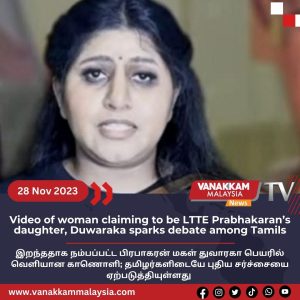A deep-fake video featuring a woman who identifies as Dwaraka Prabhakaran, daughter of Velupillai Prabhakaran, founder-chief of the Liberation Tigers of Tamil Eelam, has gone viral in recent weeks.
The video is believed to be an attempt by pro-LTTE groups in Scandinavia and Canada to revive the LTTE ideology in Sri Lanka, according to Sri Lankan defense experts. The video could be used by certain political parties to gain political mileage in the upcoming parliamentary elections, they claim.
The video is said to have gone viral in Sri Lanka, particularly in regions where the Tamil community holds a dominant presence. It was launched on November 27, which the LTTE observes as Maaveerar Naal (Great Heroes Day or Martyrs’ Day), a day of remembrance observed by pro-Tiger sections among Sri Lankan Tamils to honor the LTTE’s fallen fighters.
During her 12-minute speech in the video, the woman asserted that the Sri Lankan government had sought aid from powerful nations when they couldn’t confront the LTTE directly. She reiterated the LTTE’s commitment to the ongoing fight for freedom, highlighting the importance of unity in diversity for political purposes.
This video was probably produced and released by pro-LTTE diaspora groups, Uditha Devapriya, the lead researcher of Factum, a Colombo-based think tank, told The Diplomat.
Formed in 1972, the LTTE fought the Sri Lankan Army until its military defeat in 2009. Its entire leadership, including Prabhakaran and his family members, were killed in the final days of the war.
However, there remains a sizeable section within the country and abroad that holds onto the aspiration of establishing a separate state for Tamils in Sri Lanka. Some also believe or project the claim that Prabhakaran and his kin are alive.
According to Devapriya, leaders in this section of the Tamil diaspora greatly profit from donations. They actively seek to radicalize Sri Lankan Tamil youth and perpetuate the vision of Eelam among segments of former cadres.
“The foundation of the LTTE revolved around Velupillai Prabhakaran, and his family holds a revered status among its supporters,” Devapriya said, pointing out that “since the war’s conclusion, there have been persistent efforts to persuade supporters and the Tamil populace that members of Prabhakaran’s family are still alive.”
As recently as last week, Vaiko, general secretary of the Marumalarchi Dravida Munnetra Kazhagam (MDMK), which is based in India’s southern state of Tamil Nadu, claimed that the Tamil Tiger leader is still alive. In February 2023, Pazha Nedumaran, a Tamil nationalist also based in Tamil Nadu, asserted that Prabhakaran is alive and well, hinting at an imminent public appearance.
A simple Google search querying “Is Prabhakaran alive” yields numerous statements from Tamil political leaders in India and around the world echoing the belief that the LTTE leader is alive. This narrative persists due to the receptive audience that exists for such claims.
Indika Perera, a Sri Lankan defense analyst and conflict resolution expert, shared with The Diplomat that he has discussed the deep fake videos with several Tamils, both in the Tamil-dominated Northern Province of Sri Lanka and Western countries.
Perera said there is a division of opinion among Tamils, with perspectives influenced by age and political beliefs. “Younger Tamils perceive this video as beneficial for their community,” he said, noting, however, that “staunch supporters in their late 40s and 50s view the video as an affront to the Prabhakaran family.” In response to the video, “there has been a surge in memes containing derogatory content aimed at Prabhakaran’s daughter,” Perera said.
Furthermore, he pointed out that Tamil political parties perceive this situation as an opportunity to gain traction ahead of the upcoming general election.
“Ultimately, both the video itself and the attempts by political entities to leverage it serve to sustain the enduring aspiration for Eelam,” Perera said.
According to Mahil Dole, head of Sri Lanka’s counterintelligence and counter-terrorism operations during the last phase of the war against the LTTE, the video of Prabhakaran’s purported daughter was released to motivate pro-LTTE elements in Sri Lanka and abroad.
Extremist groups require manpower, motivation, and money to sustain their activities. The video was intended to inspire people.
Sri Lankan intelligence agencies need to exercise extreme vigilance, he said, drawing attention to numerous groups in the West, particularly in Norway, that persist in upholding the Eelam ideology. “These groups will continuously devise motivational strategies to keep their ideology alive. The deep fake video is just one example, and there will likely be many more in the future,” he said.
“We must remember Prabhakaran’s words in his August 4, 1987 speech at Suthumalai Amman Kovil in the Jaffna peninsula where he stated that ‘the methods of war may change, but the aim of our war will not change,’” Dole recalled.
He called for adopting a proactive approach to intelligence gathering as certain groups, including some rehabilitated cadres, have not given up on the idea of Eelam.
“They still adhere to the Sun Tzu art of war philosophy, rooted in the notion that deception is integral to warfare. Their approach is to comply with the enemy’s directives when in a disadvantaged position. Their primary focus is on survival to engage another day. This sentiment was echoed by individuals I’ve spoken to,” Dole said.
“Therefore,” he warned, Sri Lanka needs to exercise utmost caution.”

































